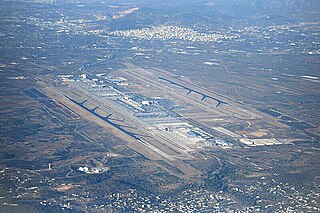
Athens International Airport Eleftherios Venizelos, commonly initialised as AIA, is the largest international airport in Greece, serving the city of Athens and region of Attica. It began operation on 28 March 2001 and is the main base of Aegean Airlines, as well as other smaller Greek airlines. It replaced the old Ellinikon International Airport.

Saudia, formerly known as Saudi Arabian Airlines, is the flag carrier of Saudi Arabia, based in Jeddah. The airline's main hub is at King Abdulaziz International Airport in Jeddah and King Khalid International Airport in Riyadh, with it planning to pull out of Riyadh as a major hub by 2030.

Kai Tak Airport(IATA: HKG, ICAO: VHHH) was an international airport of Hong Kong from 1925 until 1998. Officially known as Hong Kong International Airport from 1954 to 6 July 1998, it is often referred to as Hong Kong International Airport, Kai Tak, or simply Kai Tak and Kai Tak International Airport, to distinguish it from its successor, Chek Lap Kok International Airport, built on reclaimed and levelled land around the islands of Chek Lap Kok and Lam Chau, 30 kilometres (19 mi) to the west.
This is a list of aviation-related events from 1989.

Thessaloniki Airport, officially Thessaloniki Airport "Makedonia" and formerly Mikra Airport, is an international airport serving Thessaloniki, the second-largest city in Greece. It is located 13 km (8 mi) southeast of the city, in Thermi.

Elliniko is a coastal municipality in the Attica region and a southern suburban town in the Athens agglomeration, Greece. Since the 2011 local government reform, it is part of the municipality Elliniko-Argyroupoli, of which it is a municipal unit. Elliniko is known for the former Hellinikon Olympic Complex, a temporary sporting complex building on the grounds of the former Ellinikon International Airport used for the 2004 Summer Olympics and the 2004 Summer Paralympics.
Tower Air was a certificated FAR 121 U.S. charter airline that also operated scheduled passenger service from 1983 until 2000 when the company declared bankruptcy and was liquidated. Scheduled flights were initially offered over a New York – Brussels – Tel Aviv route in addition to charter flights to Athens, Frankfurt, Rome, and Zurich. Short-lived New York – Los Angeles flights were introduced with the addition of an ex-Avianca Boeing 747-100 in 1984. The airline was headquartered in Building 178 and later in Hangar 17 at John F. Kennedy International Airport in Jamaica, Queens, New York City.
Olympic Airlines, formerly named Olympic Airways, was the flag carrier airline of Greece. The airline's head office was located in Athens. The airline operated services to 37 domestic destinations and to 32 destinations worldwide. The airline's main base was at Athens International Airport, "Eleftherios Venizelos", with hubs at Thessaloniki International Airport, "Macedonia", Heraklion International Airport, "Nikos Kazantzakis" and Rhodes International Airport, "Diagoras". Olympic Airlines also owned a base at London Heathrow Airport. By December 2007, the airline employed about 8,500 staff.
This is a list of aviation-related events from 1976.

Pan Am Flight 845 was a scheduled international passenger flight between Los Angeles and Tokyo, with an intermediate stop at San Francisco. The flight was operated by a Boeing 747 registered N747PA and named Clipper America.

Hellenic Imperial Airways was an airline which had its head office in Ellinikon, South Athens, Greece. It operated charter and scheduled flights. The company slogan was Your direct flight around the globe!

As of July 2020, a total of 60 Boeing 747 aircraft, or just under 4% of the total number of 747s built, first flown commercially in 1970, have been involved in accidents and incidents resulting in a hull loss, meaning that the aircraft was either destroyed or damaged beyond economical repair. Of the 60 Boeing 747 aircraft losses, 32 resulted in no loss of life; in one, a hostage was murdered; and in one, a terrorist died. Some of the aircraft that were declared damaged beyond economical repair were older 747s that sustained relatively minor damage. Had these planes been newer, repairing them might have been economically viable, although with the 747's increasing obsolescence, this is becoming less common. Some 747s have been involved in accidents resulting in the highest death toll of any civil aviation accident, the highest death toll of any single airplane accident, and the highest death toll of a midair collision. As with most airliner accidents, the root of cause(s) in these incidents involved a confluence of multiple factors that rarely could be ascribed to flaws with the 747's design or its flying characteristics.

China Airlines Flight 605 was a daily non-stop flight departing from Taipei at 6:30 a.m. and arriving at Kai Tak Airport in Hong Kong at 7:00 a.m. local time. On November 4, 1993, the plane went off the runway and overran while landing during a storm. It was the first hull loss of a Boeing 747-400.
Air France has been in operation since 1933. Its aircraft have been involved in a number of major accidents and incidents. The deadliest accident of the airline occurred on June 1, 2009, when Air France Flight 447, an Airbus A330-203, flying from Rio de Janeiro to Paris crashed into the Atlantic Ocean with 228 fatalities. A selected list of the most noteworthy of these events is given below.

Olympic Airways Flight 411 was a flight from Ellinikon International Airport bound for John F. Kennedy International Airport and operated by Olympic Airways using a Boeing 747-200. On August 9, 1978, the flight came close to crashing in downtown Athens. Despite maneuvers near the edge of the flight envelope, none of the 418 passengers and crew suffered serious injury.

On 24 November 2019, a Dornier 228-201 twin turboprop aircraft operated by local carrier Busy Bee Congo crashed shortly after takeoff from Goma International Airport in a densely populated section of the city, killing 21 of the 22 on board and six on the ground. It is the deadliest accident involving the Dornier 228.

Kalitta Air Flight 207 (K4207/CKS207) was a scheduled cargo flight between John F. Kennedy Airport to Bahrain International Airport with a technical stopover at Brussels. On May 25, 2008, the Boeing 747-200 overran runway 20 during takeoff at Brussels Airport, causing the aircraft to split into three large pieces. The occupants sustained minor injuries.

Tower Air Flight 41 was a scheduled domestic passenger flight from John F. Kennedy International Airport (JFK) in New York City, to Miami International Airport (MIA) in Florida. On December 20, 1995, the Boeing 747-100 operating the flight veered off the runway during takeoff from JFK. All 468 people on board survived, but 25 people were injured. The aircraft was damaged beyond repair and written off, making the accident the 25th hull loss of a Boeing 747. The National Transportation Safety Board (NTSB) concluded that the captain had failed to reject the takeoff in a timely manner.


















